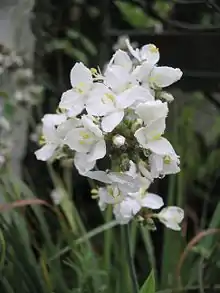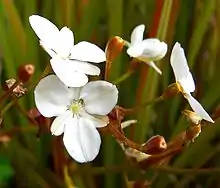Libertia
Libertia is a genus of monocotyledenous plants in the family Iridaceae, first described as a genus in 1824.[2] It is native to South America, Australia, New Guinea, and New Zealand. Seven species are endemic to New Zealand.[1][3][4]
| Libertia | |
|---|---|
 | |
| Libertia grandiflora | |
| Scientific classification | |
| Kingdom: | Plantae |
| Clade: | Tracheophytes |
| Clade: | Angiosperms |
| Clade: | Monocots |
| Order: | Asparagales |
| Family: | Iridaceae |
| Subfamily: | Iridoideae |
| Tribe: | Sisyrinchieae |
| Genus: | Libertia Spreng. 1824, conserved name not Dumort. 1822 (syn of Hosta) nor Lej. 1825 (syn of Bromus) |
| Type species | |
| Libertia ixioides (Forster f.) Spreng. | |
| Synonyms[1] | |
| |

Libertia is made up of herbaceous or evergreen perennials growing from short rhizomes,[2] with simple, linear or narrowly lanceolate basal leaves which are often green but may be red, orange, or yellow under direct sunlight.[5] The showy white or blue trimerous flowers are open in spring and are followed by capsules opening by three valves which contain the numerous seeds.[6]
The genus was named after the Belgian botanist Marie-Anne Libert[7] (1782–1865) (also referred to as Anne-Marie Libert).[8]
The species Libertia chilensis has gained the Royal Horticultural Society’s Award of Garden Merit.[9][10]
- Species[1]
- Libertia chilensis (Molina) Gunckel - central + southern Chile, southern Argentina, Juan Fernández Islands
- Libertia colombiana R.C.Foster - Colombia, Ecuador, Peru, Bolivia
- Libertia cranwelliae Blanchon, B.G.Murray & Braggins - North Island of New Zealand [3]
- Libertia edgariae Blanchon, B.G.Murray & Braggins - North Island of New Zealand[3]
- Libertia falcata Ravenna - Los Lagos region of Chile
- Libertia flaccidifolia Blanchon & J.S.Weaver - North Island of New Zealand
- Libertia grandiflora (R.Br.) Sweet - North + South Islands of New Zealand
- Libertia insignis Ravenna - Los Lagos region of Chile
- Libertia ixioides (G.Forst.) Spreng. - North + South Islands of New Zealand
- Libertia mooreae Blanchon, B.G.Murray & Braggins - North + South Islands of New Zealand[3]
- Libertia paniculata (R.Br.) Spreng. - eastern Australia [11] - Branching Grass Flag
- Libertia peregrinans Cockayne & Allan - North + South + Chatham Islands of New Zealand
- Libertia pulchella (R.Br.) Spreng. - New South Wales, Victoria, Tasmania, North + South Islands of New Zealand, New Guinea[4][12]
- Libertia sessiliflora (Poepp.) Skottsb. - central Chile
- Libertia tricocca Phil. - central + southern Chile
- Libertia umbellata Ravenna - Los Lagos region of Chile
- Selected formerly included[1]
Numerous names have been coined using the name Libertia, referring to species that are now regarded as better suited to other genera (Bromus Cardiocrinum Hosta Orthrosanthus).
- Libertia arduennensis - Bromus bromoideus
- Libertia arundinacea - Bromus bromoideus
- Libertia azurea - Orthrosanthus multiflorus
- Libertia cernua - Hosta plantaginea
- Libertia graminea - Orthrosanthus laxus var. gramineus
- Libertia heteroclita - Cardiocrinum cordatum
- Libertia laxa - Orthrosanthus laxus
- Libertia recta - Hosta ventricosa
- Libertia stricta - Orthrosanthus multiflorus
Cytology
Libertia has a high rate of polyploidy, with 9/11 of assessed species confirmed as polyploid and only 2 confirmed as diploid.[3] This is not unprecedented, with polyploidy being a common feature in the tribe Sisyrinchieae.[13] The uniform base number of x=19[13] is, however, defining within the tribe. This base number is not found elsewhere in the tribe and only Diplarrhena and Solenomelus have uniform base numbers intragenerically.[13]
All New Zealand endemic species of Libertia are hexaploid or dodecaploid,[14][15][16][17][3] while these levels of ploidy have not been found outside New Zealand. Polyploidy is more prevalent in New Zealand species across all botanical taxa[18][19] and this has been attributed as a relic of glacial refugia during glacial maximums.[20]
| Distribution | Species | Ploidy Level | Chromosomal Count | Contention |
|---|---|---|---|---|
| South American | L. chilensis | 4x (6x) | 76[15] (72, 114)[21] | Due to numerous issues with this study, authors found the sample, identified as Libertia ixioides (New Zealand endemic) but collected from Chile, to have 72 chromosomes present.[22] This was most likely a misidentification of Libertia chilensis, with a further error in counting.
Samples from the Juan Fernandez Islands were found to have 114 chromosomes, in comparison to the 76 found on the mainland.[21] |
| South American | L. colombiana | No data available. | No data available. | |
| New Zealand endemic | L. cranwelliae | 12x | 228[3] | |
| New Zealand endemic | L. edgariae | 6x | 114[3] | |
| South American | L. falcata | No data available. | No data available. | |
| New Zealand endemic | L. flaccidifolia | 12x | 228[14] | |
| New Zealand endemic | L. grandiflora | 6x | 114[17] (228, 230)[14] | The 228/230 chromosome specimen was likely Libertia flaccidifolia,[17] before the 2009 naming by Blanchon and Weaver.[14] |
| South American | L. insignis | No data available. | No data available. | |
| New Zealand endemic | L. ixioides | 12x | 228[17] (220-230, 230)[15] | Due to the difficulty in counting chromosomes, authors found between 220 and 230 chromosomes in different counts, with 228 being the average count.[15] |
| New Zealand endemic | L. mooreae | 6x | 114[3] | |
| Australian | L. paniculata | 4x | 76[15] | |
| New Zealand endemic | L. peregrinans | 6x | 114[16] | |
| Australasia-New Zealand | L. pulchella | 2x | 38[16] | |
| South American | L. sessiliflora | 2x | 38[15] | |
| South American | L. tricocca | No data available. | No data available. | |
| South American | L. umbellata | No data available. | No data available. |
References
- Kew World Checklist of Selected Plant Families
- Sprengel, Curt Polycarp Joachim 1824. Systema Vegetabilium, editio decima sexta 1: 127 in Latin
- Blanchon, D.J.; et al. (2002). "A taxonomic revision of Libertia (Iridaceae) in New Zealand". New Zealand Journal of Botany. 40 (3): 437–456. doi:10.1080/0028825x.2002.9512805. S2CID 83634447.
- "Census of vascular plants of Papua New Guinea". Retrieved 2010-01-01.
- "Stephen Butler | IGPS Blog". igpsblogs.wordpress.com. Retrieved 2017-03-12.
- Goldblatt; Henrich; Keating, Peter; James; Richard (1989). "Seed morphology of Sisyrinchium (Iridaceae-Sisyrinchieae) and its allies". Annals of the Missouri Botanical Garden. 76 (4): 1109–1117. doi:10.2307/2399695. JSTOR 2399695.CS1 maint: multiple names: authors list (link)
- Quattrocchi, Umberto (2006). CRC World Dictionary of Grasses, Common Names, Scientific Names, Eponyms, Synonyms, and Etymology. 1. Taylor and Francis. p. 124. ISBN 9781420003222.
- Manning, John; Goldblatt, Peter (2008). The Iris Family: Natural History & Classification. Portland, Oregon: Timber Press. pp. 215–16. ISBN 978-0-88192-897-6.
- "RHS Plantfinder - Libertia chilensis". Retrieved 22 March 2018.
- "AGM Plants - Ornamental" (PDF). Royal Horticultural Society. July 2017. p. 60. Retrieved 14 March 2018.
- "Libertia paniculata". Australian Plant Name Index (APNI), IBIS database. Centre for Plant Biodiversity Research, Australian Government.
- "Libertia pulchella". Australian Plant Name Index (APNI), IBIS database. Centre for Plant Biodiversity Research, Australian Government.
- Goldblatt; Takei, P.; M. (1997). "Chromosome cytology of Iridaceae-patterns of variation, determination of ancestral base numbers, and modes of karyotype change". Annals of the Missouri Botanical Garden. 85 (2): 285–304. doi:10.2307/2400005. JSTOR 2400005.CS1 maint: multiple names: authors list (link)
- Blanchon; Weaver, D.J.; J.S. (2009). "Libertia flaccidifolia (Iridaceae), a new species from Mt. Tamahunga, Northland, New Zealand". New Zealand Journal of Botany. 47 (3): 317–324. doi:10.1080/00288250909509812. S2CID 86060799.CS1 maint: multiple names: authors list (link)
- Blanchon, D.J. (2000). "Chromosome numbers in the genus Libertia". New Zealand Journal of Botany. 38 (2): 245–250. doi:10.1080/0028825x.2000.9512681.
- Hair; Beuzenberg; Pearson, J.B.; E.J.; B. (1967). "Contributions to a chromosome atlas of the New Zealand flora - 9. Miscellaneous families". New Zealand Journal of Botany. 5: 185–196. doi:10.1080/0028825x.1967.10428739.CS1 maint: multiple names: authors list (link)
- Moore, L.B. (1967). "The New Zealand species of Libertia (Iridaceae)". New Zealand Journal of Botany. 5 (2): 255–275. doi:10.1080/0028825x.1967.10428745.
- Rendle; Murray, H.; B.G. (1989). "Chromosome relationships and breeding barriers in New Zealand species of Ranunculus". New Zealand Journal of Botany. 27 (3): 437–444. doi:10.1080/0028825x.1989.10414124.CS1 maint: multiple names: authors list (link)
- Murray; Cameron; Standring, B.G.; E.K.; L.S. (1992). "Chromosome numbers, karyotypes, and nuclear DNA variation in Pratia Gaudin (Lobeliaceae)". New Zealand Journal of Botany. 30 (2): 181–187. doi:10.1080/0028825x.1992.10412897.CS1 maint: multiple names: authors list (link)
- McQueen, D.R. (1992). "Disjunction of tree species in mountain forests, southern North Island, New Zealand: a review of paleobotanical evidence". Pacific Science. 46 (2): 269–275.
- Sanders; Stuessy; Rodriguez, R.W.; T.F.; R. (1983). "Chromosome numbers from the flora of the Juan Fernandez Islands". American Journal of Botany. 70 (6): 799–810. doi:10.2307/2442929. JSTOR 2442929.CS1 maint: multiple names: authors list (link)
- Kenton; Heywood, A.; C.A. (1984). "Cytological studies in South American Iridaceae". Plant Systematics and Evolution. 146 (1–2): 87–104. doi:10.1007/bf00984056. S2CID 39542853.CS1 maint: multiple names: authors list (link)
| Wikispecies has information related to Libertia. |
